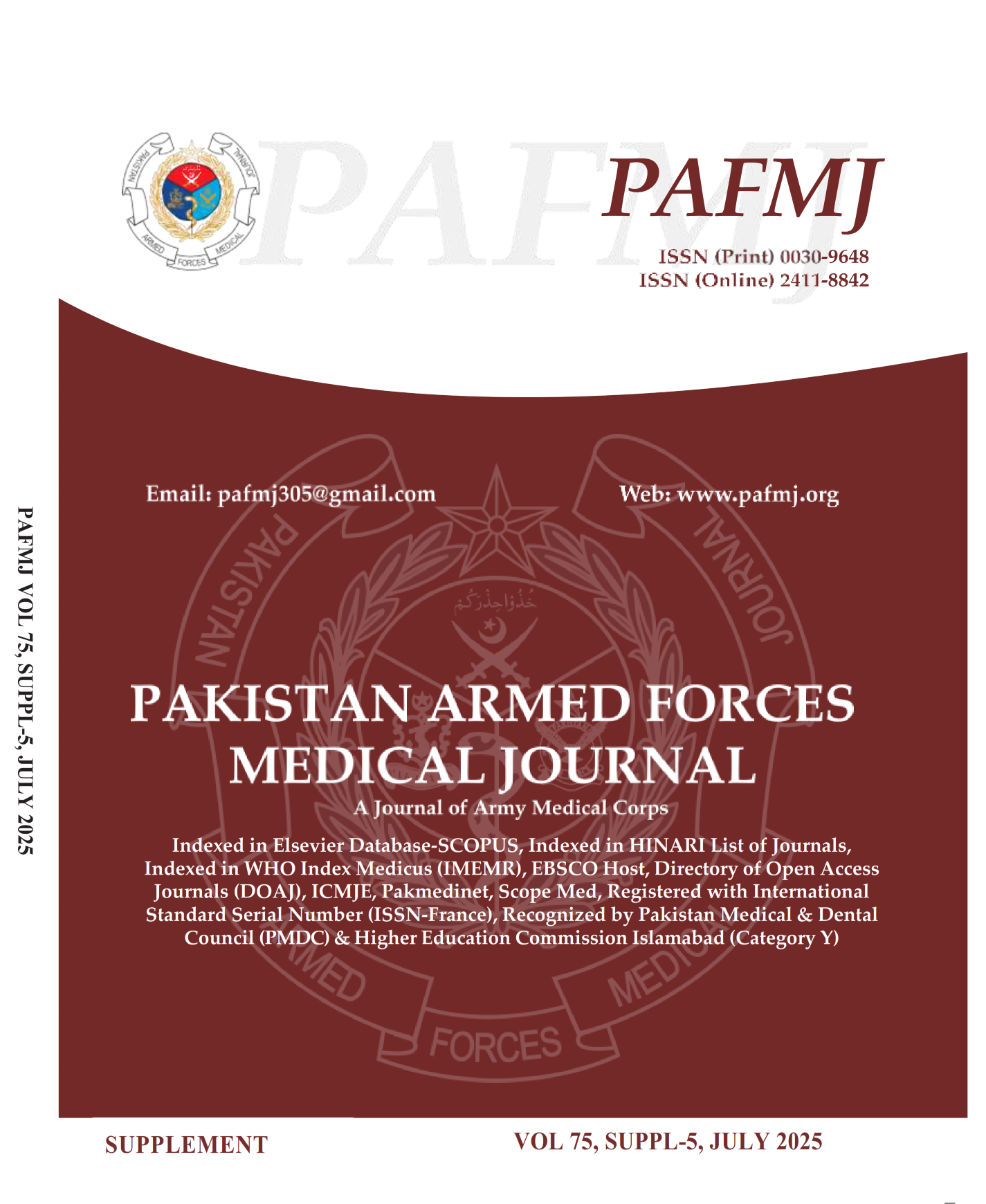Effectiveness of Lignocaine Spray At Laryngeal Inlet Versus Intravenous Lignocaine in Reducing Cough At Extubation
DOI:
https://doi.org/10.51253/pafmj.v75iSUPPL-5.8813Keywords:
Cough, Endo tracheal tube, Lignocaine, Post operative sore throatAbstract
Objective: To ascertain effectiveness of topical lignocaine when compared with IV lignocaine during extubation in terms of reduction in cough.
Study Design: Quasi Experimental Study.
Duration and Place of Study: Anesthesiology department, Combined Military Hospital, Rawalpindi, Pakistan, from Jul 2021 to Dec 2021.
Methodology: A total of 160 patients were separated into two Groups of similar size. During the introduction of the laryngoscope in Group A, 2 puffs of 10% lignocaine were sprayed on vocal cords prior to insertion of the Endo Tracheal Tube. Approximately 10 mg of lignocaine was present in each puff. During induction, patients in Group B did not receive any lignocaine, but during extubation, 1.5-2 mg/kg IV lignocaine was administered.
Results: Mean age of all patients was 37.25±13.44 years whereas mean BMI was 28.80±3.86. Gender distribution showed that 116 (72.5%) were males while 44 (27.5%) were females. There were a total of 51(31.9%) patients who developed cough while being extubated out of which 29 (26.3%) patients belonged to topical lignocaine Group and 22(27.5%) patients in IV lignocaine Group (p-value=0.309). Post-operative sore throat (p-value=0.746), dysphagia (p-value=0.990) and dysphonia (p-value=0.620) were also insignificant in two Groups.
Conclusion: When compared to a global intravenous injection of 2% lignocaine, a combination of 10% lignocaine spray on the laryngeal inlet demonstrates equivalent effectiveness in minimising coughing during extubation. In two Groups, the side effects were likewise comparable.
Downloads
References
1. Sakae TM, de Souza RL, Brandão JC. Impact of topical airway anesthesia on immediate postoperative cough/bucking: a systematic review and meta-analysis. Brazilian Journal of Anesthesiology (English Edition). 2021 Apr 22.
2. Singh NP, Makkar JK, Cappellani RB, Sinha A, Lakshminarasimhachar A, Singh PM. Efficacy of topical agents for prevention of postoperative sore throat after single lumen tracheal intubation: a Bayesian network meta-analysis. Canadian Journal of Anesthesia/Journal canadien d'anesthésie. 2020; 67(11): 1624-42.
3. Wei CH, Pengling SU, Liye YA, Jun PU, Hongbin YU, Mouli TI. Improving endotracheal tube tolerance with intracufflidocaine: a meta-analysis of randomized controlled trials. Journal of Medical Colleges of PLA. 2013 ; 28(5): 302-12.
4. Fang P, Zong Z, Lu Y, Han X, Liu X. Effect of topical ropivacaine on the response to endotracheal tube during emergence from general anesthesia: a prospective randomized double-blind controlled study. BMC anesthesiology. 2018; 18(1): 1-6.
5. Shabnum T, Ali Z, Naqash IA, Mir AH, Azhar K, Zahoor SA, Mir AW. Effects of lignocaine administered intravenously or intratracheally on airway and hemodynamic responses during emergence and extubation in patients undergoing elective craniotomies in supine position. Anesthesia, Essays and Researches. 2017; 11(1): 216.
6. Liao AHW, Yeoh SR, Lin YC, et al. Lidocaine lubricants for intubation-related complications: a systematic review and meta-analysis. Can J Anesth. 2019; 66: 1221-39.
7. . Roberts MH, Gildersleve CD. Lignocaine topicalization of the pediatric airway. Paediatr Anaesth. 2016; 26: 337-44.
8. Mihara T, Uchimoto K, Morita S, et al. The effificacy of lidocaine to prevent laryngospasm in children: A systematic review and meta-analysis. Anaesthesia. 2014; 69: 1388-96.
9. Yang SS, Wang NN, Postonogova T, et al. Intravenous lidocaine to prevent postoperative airway complications in adults: a systematic review and meta-analysis. Br J Anaesth. 2020; 124: 314-23.
10. Soltani HA, Aghadavoudi O. The effect of different lidocaine application methods on postoperative cough and sore throat. J Clin Anesth. 2002; 14(1): 15-18.
https://doi 10.1016/s0952-8180(01)00344-0.
11. . Woodruff C, Wieczorek PM, Schricker T, et al. Atomised lidocaine for airway topical anaesthesia in the morbidly obese: 1% Compared with 2%. Anaesthesia. 2010; 65: 12-7.
12. Takekawa K, Yoshimi S, Kinoshita Y. Effects of intravenous lidocaine prior to intubation on postoperative airway symptoms. J Anesth. 2006; 20(1): 44–47.
https://doi 10.1007/s00540-005-0363-8
13. Tanaka Y, Nakayama T, Nishimori M, et al. Lidocaine for preventing postoperative sore throat. Cochrane Database Syst Rev. 2015; 14: CD004081.
14. Mekhemar NA, El-Agwany AS, Radi WK, El-Hady SM. Comparative study between benzydamine hydrochloride gel, lidocaine 5% gel and lidocaine 10% spray on endotracheal tube cuff as regards postoperative sore throat. Braz J Anesthesiol. 2016; 66(3): 242–248.
https://doi 10.1016/j.bjane.2014.09.007
15. . Kuriyama A, Maeda H, Sun R. Topical application of magnesium to prevent intubation-related sore throat in adult surgical patients: a systematic review and meta-analysis. Can J Anesth.2019; 66: 1082---94.
16. Paltura C, Güvenc¸ A, Develioglu ÖN, et al. Original Research: Aerosolized Lidocaine: Effective for Safer Arousal After Suspension Laryngoscopy. J Voice. 2020; 34: 130-3.
17. Thongrong C, Kasemsiri P, Thamburanawit W, Poomsawat S. Comparison of the effectiveness of lidocaine sprayed at the laryngeal inlet and the endotracheal tube cuff versus intravenous lidocaine for reducing cough during extubation: A prospective randomized controlled trial. Anaesthesia, Pain & Intensive Care. 2020 ; 24(4): 403-10.
https://doi 10.35975/apic.v24i4.1312-403
18. D´Aragon F, Beaudet N, Gagnon V, Martin R, Sansoucy Y. The effects of lignocaine spray and intracuff alkalinized lidocaine on the occurrence of cough at extubation: a double-blind randomized controlled trial. Can J Anaesth. 2013; 60(4): 370-376. https://doi 10.1007/s12630-013-9896-8
Downloads
Published
Issue
Section
License
Copyright (c) 2025 Ahmed Sarfaraz, Waqas Tariq, Khalid Buland, Muhammad Rashid Iqbal, Syed Rafat Ali hashmi, Muhammad aaftab Munir

This work is licensed under a Creative Commons Attribution-NonCommercial 4.0 International License.















